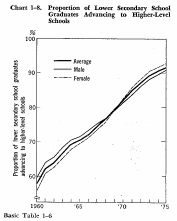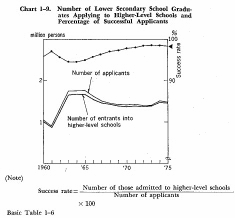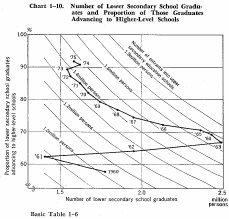| Home > Policy > White Paper, Notice, Announcement > White Paper > EDUCATIONAL STANDARDS IN JAPAN 1975 > CHAPTER1 3 (1) a | ||
The proportion of lower secondary school graduates going on to upper secondary education schools (upper secondary schools and technical colleges) stood at 42.5% in 1950, but exceeded 50% in 1954 (50.9%). Thereafter, boosted by economic growth and the growing demand for education, it showed a rapid increase, exceeding 60% in 1961, 70% in 1965 and 80% in 1970, as indicated in Chart 1-8. It continued to increase in subsequent years as well, though at a slower pace, rising to 91.9% in 1975.

Classified by sex, the advancement rate for male graduates stood at 59.6% in 1960, or 3.7% higher than the 55.9% for female graduates, but the rate for female graduates, showing a rapid advance in subsequent years, surpassed that of male graduates in 1969, climbing to 93.0% in 1975, higher than the 91.0% for male graduates.
With regard to the relationship of the number of applicants to upper secondary schools and technical colleges to that of entrants into those schools, the rate of successful applicants (the proportion of entrants into higher-level schools among total applicants) had sunk to the 94% level during the period 1963-65, as shown in Chart 1-9, due to the great number of lower secondary school graduates, but gradually climbed in subsequent years, registering at over 98% after 1972.

Next, the growth process in the rate of lower secondary school graduates going on to upper secondary education schools is shown in Chart 1-10 in relation to the transition in the number of lower secondary school graduates. It indicates that, while this rate showed a consistent increase from 1960 through 1975, there is a discrepancy between the number of lower secondary school graduates and that of entrants into upper secondary education schools in the periods 1962-63, 1964-69 and 1970-73.

That is, the number of lower secondary school graduates rose
sharply during the period 1962-63 as a result of the baby-boom during the immediate
post-World War ![]() years, totalling 2.5 million in 1963, or up 77.7% (by 1,090,000
persons) from 1.4 million in 1961. Despite such a sharp increase in the number
of lower secondary school graduates during this period, the number of entrants
into upper secondary education schools also rose from 900,000 in 1961 to 1,690,000
in 1963, so that the rate of lower secondary school graduates going on to upper
secondary education schools climbed from 62.3% in 1961 to 64.0% in 1962 and 66.8%
in 1963. And, paralleling the increase of 790,000 persons in the number of those
who went on to upper secondary education schools, the number of upper secondary
schools increased by 209 during this period.
years, totalling 2.5 million in 1963, or up 77.7% (by 1,090,000
persons) from 1.4 million in 1961. Despite such a sharp increase in the number
of lower secondary school graduates during this period, the number of entrants
into upper secondary education schools also rose from 900,000 in 1961 to 1,690,000
in 1963, so that the rate of lower secondary school graduates going on to upper
secondary education schools climbed from 62.3% in 1961 to 64.0% in 1962 and 66.8%
in 1963. And, paralleling the increase of 790,000 persons in the number of those
who went on to upper secondary education schools, the number of upper secondary
schools increased by 209 during this period.
During 1964-69, a sharp decline was shown in the number of lower secondary school graduates. Nonetheless, the number of lower secondary school graduates who went on to upper secondary education schools did not decline significantly, with the result that the percentage of those graduates going on to upper secondary education schools climbed to 79.4% in 1969, or up about 13% from 66.8% in 1963.
During 1970-73, the number of lower secondary school graduates kept declining, though at a slower pace, whereas the number of those who went on to upper secondary education schools was kept at about the same level as before, so that the rate of those who went on to upper secondary education schools rose to 89.4% in 1973, or up about 10% from 79.4% in 1969.
| Back to Top | MEXT HOME |